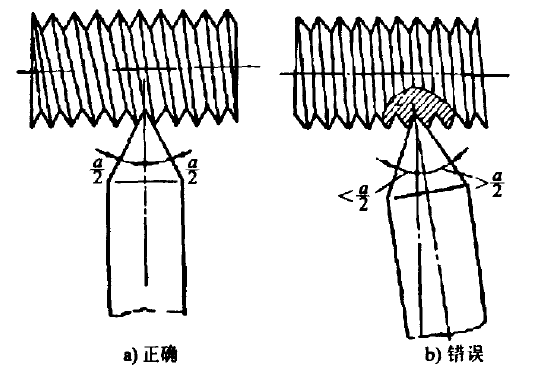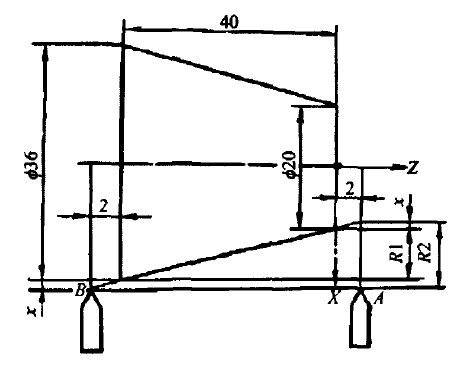
【Background introduction】
In the production process, the author has encountered a problem of chipping of external thread turning inserts. The specific working conditions are as follows:
Using an imported brand, carbide material thread turning insert, turning the external thread of hardened steel material and shaft parts after turning, the thread specification is M34×1.5.
In the process of machining, the problem of blade chipping occurs. The chipping occurs at different stages of the tool life, that is, it is not concentrated at the end of the life, and has nothing to do with the tool life setting (the tool is overused).
Although the follow-up observation of the edge of the unchipped tool found that the wear was relatively heavy, the data of "no concentration distribution" showed that the tool wear was not the most important factor leading to chipping.
When the author analyzes the machining program, it is found that the thread turning program is divided into 9 steps in total, and the thread cutting is gradually completed in the radial direction.
But in the last cut, there is no allowance, that is, the X and Z coordinate data are exactly the same as the 8th time. The reason for inquiring about the change of this project is that, during the testing phase, it was found that there were burrs on the surface of the thread, and the purpose of adding a "smooth knife" cutting without cutting allowance was precisely to remove the burrs.
However, no matter how high the precision of the equipment is, systematic errors such as return errors cannot be avoided. Therefore, the two machining trajectories cannot be completely coincident, which creates hidden dangers for chipping:
There is a cutting allowance in the "light knife" machining. Since the allowance is much smaller than the arc of the cutting edge, the rake face does not participate in cutting, and the cutting edge of the tool cannot cut into the workpiece to form continuous cutting, and only the flank face is in contact with the machined surface. , extrusion and friction, the tool will have the problem of chipping under the action of vibration.
To sum up, behind the "chipping problem" is actually the confusion in the choice of thread processing methods. So let's explain the difference between thread turning and ordinary turning.
1. Thread processing method
Threads are widely used in machinery manufacturing and other industries.
There are many processing methods for threads, among which CNC turning is one of the most commonly used processing methods at present.
Compared with ordinary turning, the feed rate of thread CNC turning is 10 times that of ordinary turning, and the cutting force at the tip of the thread turning tool is 100 to 1000 times higher.
However, factors such as fast cutting speed, large cutting force, and narrow force concentration range make CNC thread turning more difficult. Therefore, ensuring the accuracy of CNC thread turning has become the focus of processing.
2. Five factors of thread processing
A large number of practices have proved that the five aspects of threading feed method, selection of tool parameters, correct installation of tools, programming and cutting fluid have a greater impact on threading accuracy.
Factor 1 Tool geometry
Common thread cutter geometries are shown below.

Usually, the manufacturer grinds a chamfer with a width of 0.2 to 0.4 mm on the two cutting edges of the thread cutter, and its inclination angle is 5°. Because the actual profile angle will expand during high-speed thread cutting (the tip is the most worn tool). heavy position), so the tip angle should be reduced by 30°, which is usually ground to 59.5°.
The surface roughness value of the front and flank surfaces of the thread turning tool must be very small. The machine tool usually needs to choose a coating with a low friction coefficient, and the hand tool must be properly dressed when sharpening the grinding wheel or finely ground the tool with whetstone.
Factor 2 Tool installation
When turning threads, in order to ensure the correct tooth shape, stricter requirements are put forward for the installation of thread turning tools.
Take triangular thread (when turning other threads, the method of installing the turning tool is basically the same) as an example, its tooth shape is required to be symmetrical and perpendicular to the axis of the workpiece, that is, the two half angles are equal, as shown in Figure a below.

Figure 3. Installation of the thread cutter
If the turning tool is installed crookedly, the tooth profile skew as shown in Figure b above will occur.
In addition, when installing the thread turning tool, the height of the tool tip must be strictly equal to the rotation center of the workpiece.
Factor 3 Correct programming of thread turning programs
When CNC lathes process threads, the machining feed is achieved through the spindle, encoder, CNC system, and feed drive device.
The numerical control system controls the feed of the motor according to the detected spindle rotation signal, realizes the proportional relationship required by the threading, and cuts out the thread that meets the requirements.
1. When machining threads, the feed speed of the tool along the pitch direction (Z direction) has a strict matching relationship with the spindle speed. Due to the lag of the servo system of the CNC machine tool, during the acceleration and deceleration of the spindle rotation, the thread cutting will occur. The start and end points produce incorrect leads.
Therefore, a certain distance should be reserved when entering and withdrawing the tool, that is, the speed-up feed distance and the deceleration tool-retract distance.
Its value is related to the dynamic characteristics of the feed system, thread accuracy and pitch, generally δ1=2~5mm, δ2=(1/4~1/2)δ1.
Therefore, the actual Z-direction travel of the tool should include the effective length L of the thread and the distances δ1 and δ2 of the acceleration and deceleration sections.
That is, Z-direction stroke=δ1+L+δ2
The feed and retract distances are shown in the figure below.
2. When turning taper threads, since the starting and ending positions of the tool are not the starting and ending positions of the thread marked on the drawing, the difference in the radius of the thread should be the difference between the radius of the beginning and the end of the tool, otherwise the taper of the thread will be incorrect, as follows as shown in the figure.

The radius difference of the taper angle of the thread should be taken as R2 instead of R1, that is, the difference between the starting and ending radius of the tool on the thread extension line.
The calculation method is:
R2=R1+2X=8+2×0.4=8.8(mm)
X=(R1×thread extension length)/thread length=(8×2)/40=0.4(mm)
During the thread cutting cycle, the taper ends are usually extended by 2mm in the taper direction. The starting position of the tool should be greater than or equal to the diameter of the large end of the taper (point A).
The R value has positive and negative points. When the tool starts from the large end of the cone end, R is a positive value; when it starts from the small end of the cone end, R is a negative value.
3. In CNC lathes, the basic instructions for threading are G32, G92, and G76, of which G32 and G92 use radial feed cutting methods, while G76 uses lateral feed cutting methods.
When machining high-precision threads, it is not enough to simply use one command for turning. Two cutting methods can be mixed to complete the turning, that is, G76 is used for rough turning, and then G92 is used for finishing.
However, it should be noted that in thread processing, the feed rate must correspond precisely to the pitch of the thread, and the starting point of the tool must be accurate, otherwise it will be easy to buckle and cause the parts to be scrapped.
【Summary of the article】
Due to space limitations, the author will first introduce the first three items of the five factors in this article. In the next article, the author will introduce the last two items, including the most critical feeding methods and process design.